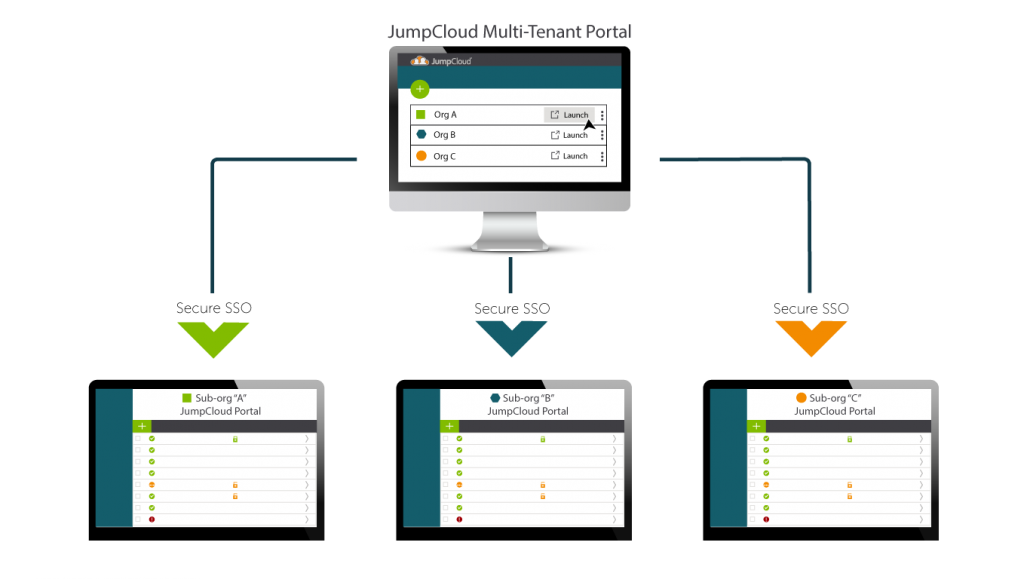Managed Service Providers (MSPs) are wondering if there is a multi-tenant version of Active Directory® (AD) that they could leverage to simplify their day-to-day work lives. Unfortunately for them, however, Microsoft® did not build Active Directory for the modern multi-tenant style needs that MSPs have today.
Why Multi-Tenant Active Directory?

The reason that MSPs are looking for a multi-tenant identity provider (IdP) to support their business, and ultimately their clients, is that MSPs are spread razor thin. With decentralized Active Directory® instances all over town, and sometimes even across the globe, MSPs find that a lot of their time is spent attending to unique problems physically. If they could centralize their customer’s identity provider and access it remotely, they could save a lot of time and money.
But, before diving into the ideal multi-tenant identity management solution, it is important to take a quick step back and understand the core needs of the space. MSPs have become more critical than ever because they are managing the IT networks of millions of small-to-medium-sized businesses (SMBs). With this sort of workload, MSPs are looking for next generation IT management tools that will enable them to manage client networks efficiently, cost-effectively, and of course remotely. Without cloud-based, multi-tenant solutions, the task of tightly controlling clients’ networks can be quite difficult. Which brings us back to Active Directory.
Active Directory Limitations

The main issue confronting MSPs stems from the fact that Active Directory (the most widely used legacy IdP), is an on-prem solution tailored for Windows®-based resources. To contrast, organizations are beginning to leverage cloud solutions (AWS®, Google Compute Engine™, Box™), web applications (Slack, GitHub, Salesforce®), and non-Windows systems like macOS® and Linux®. As a result, Microsoft has struggled to manage these solutions. Further, AD’s lack of cloud-based, multi-tenant support makes it even more difficult and costly for MSPs to manage their clients’ infrastructures. So, what is an MSP to do?
Look to the Cloud

JumpCloud Directory Platform has emerged as a reimagination of Active Directory. The aim of JumpCloud is to provide the core solution for MSPs to tightly control their clients’ networks and user access to IT resources securely and efficiently. With True Single Sign-On™ users can log in to virtually any of their IT resources with a single set of credentials. That means one set of credentials to the system (Windows®, Mac®, or Linux®), email (Gmail™, Office 365®), web and legacy apps (Jira®, Slack, OpenVPN™), cloud infrastructure (Digital Ocean, Azure®, AWS®), networks via RADIUS, and much more. That’s great for users, but what about the MSP?
JumpCloud Multi-Tenant Portal

In the vein of True Single-Sign On, JumpCloud’s Multi-Tenant Portal allows MSPs to manage all of their clients from a single pane of administrative glass. No need to log in to different portals or infrastructure to view independent clients. It’s all visible from one interface. Additionally, there are no more truck-rolls to fix simple problems, because the Multi-Tenant portal allows MSPs to view their clients’ top-level data remotely. It’s a major boon for efficiency and control.
About JumpCloud
If you’re ready to learn more about JumpCloud, feel free to contact us and one of our product experts will be happy to talk to your about our cloud-based directory services product. Additionally, you can apply to become a Partner here, or visit our YouTube channel and Knowledge Base for more information.
Learn More About JumpCloud’s Partner Program
JumpCloud’s Partner Program empowers MSPs with central identity management from the cloud. Fine-tuned for MSPs with cloud security offerings and/or clients moving to the cloud, JumpCloud can be easily bundled at the center of any product stack to make customers more secure, efficient, and scalable. Make Work Happen™ for your clients while improving the bottom line for your business.




